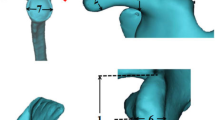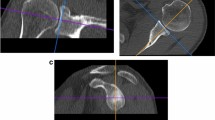Abstract
Purpose
The acromial and coracoid process morphology is of clinical relevance due to associations with functional limitations and shoulder pathology. Our objective was to describe the anatomical characteristics of the acromial and coracoid process using computed tomography (CT).
Methods
Descriptive, observational, transversal and retrospective study. A total of 155 CT of patients without shoulder pathology, of both genders, and indistinct age were evaluated and grouped by age: Group 1 < 25 years; group 2 25–40 years; group 3 > 40 years. The following parameters were evaluated: Acromial type (AcT), vertical coracoid distance (VCD), acromial tilt (AT), acromial projection (AP), critical shoulder angle (CSA), type of the subcoracoid outlet (TSO), and the area of the subcoracoid outlet (ASO).
Results
Statistically significant differences were found between men and women for VCD (14.44 ± 4.79 vs. 11.76 ± 4.00 mm; p < 0.001) and AP (3.66 ± 4.71 vs. 1.62 ± 4.99 mm; p < 0.05) as well as between age groups 1 and 3 for AT (35.08 ± 11.53 vs. 28.41 ± 6.60; p < 0.05) and ASO (398.99 ± 153.91 vs. 255.56 ± 124.58 mm2; p < 0.001). An unexpected high ASO variation was identified with 11% of S-shaped acromion and 1.3% clock-shaped TSO.
Conclusion
The age group between 25–40 years had the most uniform distribution of data. There is a high morphological variability present in an asymptomatic population, which should be considered in the clinical assessment such as shoulder impingement syndrome.






Similar content being viewed by others
References
Alraddadi A, Alashkham A, Lamb C, Soames R (2017) Variability in attachment of the coracoacromial ligament in relation with its morphology. Surg Radiol Anat 39(12):1323–1330. https://doi.org/10.1007/s00276-017-1900-5
Alraddadi A, Alashkham A, Lamb C, Soames R (2019) Examining changes in acromial morphology in relation to spurs at the anterior edge of acromion. Surg Radiol Anat 41(4):409–414. https://doi.org/10.1007/s00276-018-2141-y
Andrade R, Correia AL, Nunes J, Xará-Leite F, Calvo E, Espregueira-Mendes J, Sevivas N (2019) Is bony morphology and morphometry associated with degenerative full-thickness rotator cuff tears? A systematic review and meta-analysis. Arthroscopy 35(12):3304–3315. https://doi.org/10.1016/j.arthro.2019.07.005
Aoki M, Ishii S, Usui M (1986) The slope of the acromion and rotator cuff impingement. Orthop Trans 10:228
Balke M, Banerjee M, Vogler T, Akoto R, Bouillon B, Liem D (2014) Acromial morphology in patients with calcific tendinitis of the shoulder. Knee Surg Sport Traumatol Arthrosc 22(2):415–421. https://doi.org/10.1007/s00167-012-2327-5
Balke M, Liem D, Greshake O, Hoeher J, Bouillon B, Banerjee M (2014) Differences in acromial morphology of shoulders in patients with degenerative and traumatic supraspinatus tendon tears. Knee Surg Sport Traumatol Arthrosc. https://doi.org/10.1007/s00167-014-3499-y
Balke M, Schmidt C, Dedy N, Banerjee M, Bouillon B, Liem D (2013) Correlation of acromial morphology with impingement syndrome and rotator cuff tears. Acta Orthop 84(2):178–183. https://doi.org/10.3109/17453674.2013.773413
Bigliani L, Morrison D, April E (1986) The morphology of the acromion and its relationship to rotator cuff tears. Orthop Trans 10:216
Casier SJ, Van den Broecke R, Van Houcke J, Audenaert E, De Wilde LF, Van Tongel A (2018) Morphologic variations of the scapula in 3-dimensions: a statistical shape model approach. J Bone Jt Surg 27(12):2224–2231. https://doi.org/10.1016/j.jse.2018.06.001
Chopp-Hurley JN, O’Neill JM, Dickerson CR (2016) Distribution of bone and tissue morphological properties related to subacromial space geometry in a young, healthy male population. Surg Radiol Anat 38(1):135–146. https://doi.org/10.1007/s00276-015-1529-1
Clavert P, Jouanlanne M, Koch G (2019) Validation of the inter-individual variability of the lateral offset of the acromion. Surg Radiol Anat 41(6):693–697. https://doi.org/10.1007/s00276-019-02241-8
Coskun N, Karaali K, Cevikol C, Demirel BM, Sindel M (2006) Anatomical basics and variations of the scapula in Turkish adults. Saudi Med J 27(9):1320–1325. https://doi.org/10.1007/s00167-012-2327-5
Epstein R, Schweitzer M, Frieman B, Fenlin JJ, Mitchell D (1993) Hooked acromion: prevalence on MR images of painful shoulders. Radiology 187:479–481. https://doi.org/10.1148/radiology.187.2.8475294
Flatow EL, Soslowsky LJ, Ticker JB, Pawluk RJ, Hepler M, Ark J, Mow VC, Bigliani LU (1994) Excursion of the rotator cuff under the acromion. Patterns of subacromial contact. Am J Sports Med 22(6):779–788. https://doi.org/10.1177/036354659402200609
French ED, Alfaro-Gomez U, Guzman-Lopez S, Elizondo-Omaña R, Quiroga-Garza A, Zdilla MJ (2019) The contour of the glenoid fossa: variance in concavity. FASEB J 33(1_supplement):616–628
Gerber C, Snedeker JG, Baumgartner D, Viehöfer AF (2014) Supraspinatus tendon load during abduction is dependent on the size of the critical shoulder angle: a biomechanical analysis. J Orthop Res 32(7):952–957. https://doi.org/10.1002/jor.22621
Hijioka A, Suzuki K, Nakamura T, Hojo T (1993) Degenerative change and rotator cuff tears: an anatomical study in 160 shoulders of 80 cadavers. Arch Orthop Trauma Surg 112:61–64. https://doi.org/10.1007/BF00420255
Hyvönen P (2003) On the pathogenesis of shoulder impingement syndrome. Oulun yliopisto, pp 17–71
Jih-Yang K, Chun HS, Wei JC, Kaohsiung T, Ryuji Y (1994) Coracoid impingement caused by a ganglion from the subscapularis tendon. J Bone Jt Surg 76-A(11):1709–1711
Karns MR, Jacxsens M, Uffmann WJ, Todd DC, Henninger HB, Burks RT (2018) The critical acromial point: the anatomic location of the lateral acromion in the critical shoulder angle. J Shoulder Elb Surg 27(1):151–159. https://doi.org/10.1016/j.jse.2017.08.025
Kitay GS, Iannotti JP, Williams GR, Haygood T, Kneeland BJ, Berlin J (1995) Roentgenographic assessment of acromial morphologic condition in rotator cuff impingement syndrome. J Shoulder Elb Surg 4(6):441–448. https://doi.org/10.1016/S1058-2746(05)80036-9
Mayerhoefer ME, Breitenseher MJ, Roposch A, Treitl C, Wurnig C (2005) Comparison of MRI and conventional radiography for assessment of acromial shape. Am J Roentgenol 184:671–675. https://doi.org/10.2214/ajr.184.2.01840671
Meneses AG, Molina ÓAM, González FSV (2010) Patologías de hombro. Editor Alfil 1(1):511
Morelli KM, Martin BR, Charakla FH, Durmisevic A, Warren GL (2019) Acromion morphology and prevalence of rotator cuff tear: a systematic review and meta-analysis. Clin Anat 32(1):122–130. https://doi.org/10.1002/ca.23309
Moor BK, Bouaicha S, Rothenfluh DA, Sukthankar A, Gerber C (2013) Is there an association between the individual anatomy of the scapula and the development of rotator cuff tears or osteoarthritis of the glenohumeral joint? A radiological study of the critical shoulder angle. Bone Jt J 95 B(7):935–941. https://doi.org/10.1302/0301-620X.95B7.31028
Naidoo N, Lazarus L, Osman SA, Satyapal KS (2015) Acromial morphology and subacromial architecture in a South African population. Int J Morphol 33(3):817–825. https://doi.org/10.4067/S0717-95022015000300002
Neer C (1972) Anterior acromioplasty for the chronic impingement syndrome in the shoulder. J Bone Jt Surg Am 52-A(1):41–50
Nyffeler RW, Werner CML, Sukthankar A, Schmid MR, Gerber C (2006) Association of a large lateral extension of the acromion with rotator cuff tears. J Bone Jt Surg Am 88(4):800–805. https://doi.org/10.2106/JBJS.D.03042
Oh J, Kim J, Lee H, Choi J-A (2010) Classification and clinical significance of acromial spur in rotator cuff tear. Clin Orthop Relat Res 468:1542–1550. https://doi.org/10.1007/s11999-009-1058-5
Okoro T, Reddy VRM, Pimpelnarkar A (2009) Coracoid impingement syndrome: a literature review. Curr Rev Musculoskelet Med 2(1):51–55. https://doi.org/10.1007/s12178-009-9044-9
Pandey V, Vijayan D, Tapashetti S, Agarwal L, Kamath A, Acharya K, Maddukuri OS, Willems WJ (2016) Does scapular morphology affect the integrity of the rotator cuff? J Shoulder Elb Surg 25(3):413–421. https://doi.org/10.1016/j.jse.2015.09.016
Porter NA, Singh J, Tins BJ, Lalam RK, Tyrrell PNM, Cassar-Pullicino VN (2015) A new method for measurement of subcoracoid outlet and its relationship to rotator cuff pathology at MR arthrography. Skelet Radiol 44:1309–1316. https://doi.org/10.1007/s00256-015-2166-9
Prato N, Peloso D, Franconeri A, Tegaldo G, Ravera GB, Silvestri E, Derchi LE (1998) The anterior tilt of the acromion: radiographic evaluation and correlation with shoulder diseases. Eur Radiol 8(9):1639–1646. https://doi.org/10.1007/s003300050602
Sasiponganan C, Dessouky R, Ashikyan O, Pezeshk P, McCrum C, Xi Y, Chhabra A (2019) Subacromial impingement anatomy and its association with rotator cuff pathology in women: radiograph and MRI correlation, a retrospective evaluation. Skelet Radiol 48(5):781–790. https://doi.org/10.1007/s00256-018-3096-0
Schetino LPL, Sousa Junior RR, Amâncio GPO, Schetino MAA, Almeida-Leite CM, Silva JH (2013) Anatomical variations of acromions in Brazilian adult’s scapulas. J Morphol Sci 30(2):98–102
Stehle J, Moore SM, Alaseirlis DA, Debski RE, McMahon PJ (2015) A reliable method for classifying acromial shape. Int Biomech 2(1):36–42. https://doi.org/10.1080/23335432.2015.1014847
Totlis T, Gowd AK, Bernardoni ED, Cole BJ, Verma NN, Natsis K (2018) A simple method to directly evaluate the lateral extension of the acromion: an anatomic study of 128 cadaveric scapulae. J Shoulder Elb Surg 27(9):1694–1699. https://doi.org/10.1016/j.jse.2018.02.072
Wang JC, Shapiro MS (1997) Changes in acromial morphology with age. J Shoulder Elb Surg 6(1):55–59. https://doi.org/10.1016/S1058-2746(97)90071-9
Worland RL, Lee D, Orozco CG, SozaRex F, Keenan J (2003) Correlation of age, acromial morphology, and rotator cuff tear pathology diagnosed by ultrasound in asymptomatic patients. J South Orthop Assoc 12(1):23–26
Zuckerman JD, Kummer FJ, Cuomo F, Simon J, Rosenblum S, Katz N (1992) The influence of coracoacromial arch anatomy on rotator cuff tears. J Shoulder Elbow Surg 1(1):4–14. https://doi.org/10.1016/S1058-2746(09)80010-4
Acknowledgements
We thank Armando Gibran Franco Salazar for the help with the design of the images and Francisco Jesús Barrera Flores & Juan Manuel Millán Flores for the help in the sample size calculation and statistical analysis.
Funding
This research did not receive any specific grant from funding agencies in the public, commercial, or not-for-profit sectors.
Author information
Authors and Affiliations
Contributions
UA-G, AQ-G: conceptualization, project development, data collection/management, data analysis, manuscript writing, and manuscript editing. LDF-R, JDG-L: data collection/management, and data analysis. KIC-B: project development, data collection/management, data analysis. JFV-C: conceptualization, project development, and manuscript editing. MJZ: data analysis and manuscript editing. REE-O, GE-R, SG-L: project development, data analysis, and manuscript editing. RP-R: project development, data collection/management, and manuscript editing.
Corresponding author
Ethics declarations
Conflict of interest
The authors declare that they have no conflict of interest.
Ethical treatment
All procedures performed in studies involving human participants were in accordance with the ethical standards of the institutional and/or national research committee and with the 1964 Helsinki declaration and its later amendments or comparable ethical standards. The protocol was previously reviewed and approved by the University’s Ethics and Research Committees with the registration number AH17-00005. None of the imaging studies were performed for the purpose of this study.
Additional information
Publisher's Note
Springer Nature remains neutral with regard to jurisdictional claims in published maps and institutional affiliations.
Rights and permissions
About this article
Cite this article
Alfaro-Gomez, U., Fuentes-Ramirez, L.D., Chavez-Blanco, K.I. et al. Anatomical variations of the acromial and coracoid process: clinical relevance. Surg Radiol Anat 42, 877–885 (2020). https://doi.org/10.1007/s00276-020-02497-5
Received:
Accepted:
Published:
Issue Date:
DOI: https://doi.org/10.1007/s00276-020-02497-5




